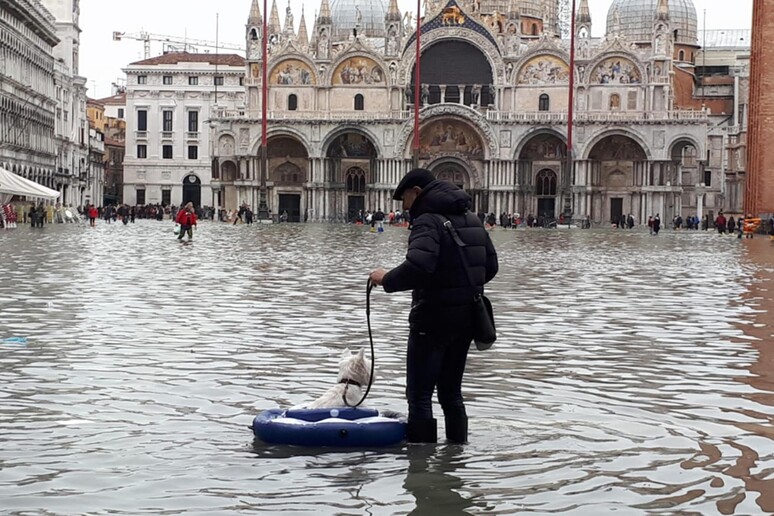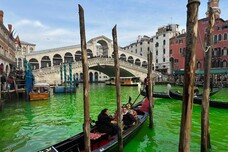Venice was hit by 'acqua alta'
or high water flooding of 144cm on Monday.
Some 60% of the ground in the lagoon city was under water.
A potentially critical acqua alta of 150 cm had been
forecast, but winds off the Adriatic staved it off.
Levels of 100-120 cm above sea level are fairly common
in the lagoon city and Venice is well-equipped to cope with
its rafts of pontoon walkways.
But anything much above 120cm risks swamping much of the
city.
Venice was brought to its knees on November 13 due to
flooding in much of the city after the high-water mark reached
187cm, close to the level of the famous 1966 flood.
A 78-year-old man was electrocuted due a flood-caused short
circuit at his home on the island of Pellestrina.
Another person also died.
St Mark's basilica and La Fenice theatre were among the
buildings damaged.
The causes of acqua alta are both natural and man-made.
Decades of pumping groundwater caused significant damage to
the delicate foundation before the practice was called off.
Weather experts say the high-water threat has been
increasing in recent years as heavier rains have hit northern
Italy.
Other possible explanations for the phenomenon include the
sea floor rising as a result of incoming silt and gas extraction
in the sea off Venice undermining the islands.
According to a recent study, plate tectonics are also to
blame as the Adriatic plate is sliding beneath the Apennine
Mountains, causing the area to drop in elevation.
Scientists have conceived various ways of warding off the
waters since a catastrophic flood in 1966 and a system of
moveable flood barriers called MOSE is near completion after
years of controversy.
The final practical tests of MOSE, Venice's new flood-barrier
system whose lack was lamented over the disastrous and deadly
flooding, will begin testing next year, the Consorzio Venezia
Nuova consortium has said.
Experimental raising of the barriers is already scheduled for
the whole of 2020, it said, at a rate of one every 45 days.
There has been controversy over a failure to ready the MOSE
project in time for the 187 cm tide that wrecked the lagoon
city and killed two people.
The MOSE system must be finished despite its being already
obsolete, Foreign Minister and anti-establishment 5-Star
Movement (M5S) leader Luigi Di Maio said.
Projects like MOSE, which are currently due to be up and
running in 2021, were "born old and stuffed with kickbacks and
corruption but now, although it isn't the best possible
solution, it must be completed as soon as possible to protect
Venice immediately", he said.
"We won't pretend not to see where the blame lies," he said.
In September the updated 2018 balance sheet of the consortium
building MOSE said the flood barriers will be handed over to the
city council at the end of 2021 to protect the lagoon city from
acqua alta or high water levels such as the 187 cm tide that hit
Monday, the highest in 50 years.
The innovative and complex system of barriers, which cost 74
million euros in 2018 alone, will be completed at the end of
June 2020, ushering in the final phase of testing.
Launched in 2003 and originally slated for completion in
2016, the MOSE project to build a system of retractable dikes
has been at the centre of a slew of corruption scandals.
MOSE stands for MOdulo Sperimentale Elettromeccanico, or
Experimental Electromechanical Module, and echoes Moses of
parting the Red Sea fame.
The 5.5 billion euro (up by 1.3 billion form the first
estimate) project is intended to protect the city of Venice and
the Venetian Lagoon from flooding.
The project is an integrated system consisting of rows of
mobile gates installed at the Lido, Malamocco, and Chioggia
inlets that are able to isolate the Venetian Lagoon temporarily
from the Adriatic Sea during acqua alta high tides.
Together with other measures, such as coastal reinforcement,
the raising of quaysides, and the paving and improvement of the
lagoon, MOSE is designed to protect Venice and the lagoon from
tides of up to 3 metres (9.8 ft).
The Consorzio Venezia Nuova is responsible for the work on
behalf of the Ministry of Infrastructure and Transport - Venice
Water Authority.
Construction began simultaneously in 2003 at all three lagoon
inlets, and as of June 2013, more than 85% of the project had
been completed.
ALL RIGHTS RESERVED © Copyright ANSA











